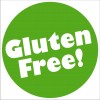
“It took nine years. But we did it. All of us. Every single member of the gluten-free community, whether you’ve been diagnosed for 20 years or 20 days. We all played a role in getting the FDA to finalize a definition because people living with and affected by gluten-related disorders are not a small minority of people. By speaking up together, we’ve proven that this community is large and we have a big voice. The final rule means that the gluten-free community has been heard.” Alice Bast, Founder of National Foundation for Celiac Awareness
On August 5, 2014 the U.S. Food and Drug Administrations’ gluten-free labeling law finally went into effect. The term gluten-free is now “officially” regulated by a governmental agency. Products labeled gluten-free must now meet standards set forth by the FDA on August 2, 2013. You can view the terms HERE. Many in the celiac/gluten-sensitive community are excited the FDA took this step towards ensuring products containing a gluten-free label are safe for our community, though many also wish the law was even stricter … requiring manufacturers to test products (though we certainly hope this is going to be the case!) … preferring a requirement of a lower threshold of acceptable gluten – 5 to 10 PPM (parts per million) or even 0 gluten as opposed to the allowable 20 PPM (considered safe according to leading celiac experts). People who are highly sensitive and react to even trace amounts of gluten, need to keep this in mind, and select gluten-free products that are tested to a lower amount or include no gluten at all. Other frequently asked questions in the community are whether the law covers non-food products such as medications and alcohol, whether products falling under USDA regulations such as meat & poultry are included under the labeling law, and if restaurants offering gluten-free options are required to comply.
The new labeling law is certainly a step in the right direction, and we have cause to celebrate, but our community still needs to remain diligent in our efforts to keep safe, when making our purchases and ordering from a gluten-free menu. The National Foundation for Celiac Awareness (NFCA) invited CeliacCorner to question celiac advocate Tricia Thompson, MS, RD, Owner/Founder of Gluten Free Watchdog, LLC to address some of these concerns.
Following is our Q&A with Trisha:
Q. Are you satisfied with FDA labeling law for gluten-free products which went into effect August 5th, 2014? What does it cover, and what does it not cover?
A. The gluten-free labeling rule is a step in the right direction but no, I am not completely satisfied. Under the rule, manufacturers who make a gluten-free labeling claim do not have to test their foods for gluten contamination. That said, manufacturers are responsible for ensuring the claim is accurate. The only way to do this is to test–frequently and using state-of-the-art methodology.
The FDA’s gluten-free rule covers packaged foods intended for human use. The rule does not cover foods regulated by the United States Department of Agriculture, alcohol regulated by the Alcohol Tobacco Tax and Trade Bureau, cosmetics, medications, and meals served in restaurants.
Q. What should consumers look for when shopping in grocery aisles?
A. Consumers should look for foods labeled gluten-free and/or certified gluten-free by a third party certification organization, such as the Gluten-Free Certification Program endorsed by the National Foundation for Celiac Awareness and the Canadian Celiac Association. Not all foods purchased at the store have to be labeled gluten-free. Due to issues with cross-contact foods that are naturally gluten-free grains or flours or made from naturally gluten-free grains or flours should be labeled gluten-free.
Q. Do the guidelines offer enough assurance for individuals following a medically necessary gluten-free diet?
A. Some individuals are happy with the less than 20 part per million gluten threshold set by the FDA. Others want products that comply with the gluten threshold levels stipulated by third party certification program which in the US vary from less than 5 ppm gluten to no more than 10 ppm gluten.
Q. Do you believe there is still a need for separate gluten-free certification of products beyond the FDA ruling on gluten-free, especially for those who must be gluten-free for medical reasons?
A. Because testing is not required by the FDA, there is the need for third party certification programs. However, these programs must require a robust testing program that is transparent to consumers. Additionally, a protocol must be in place to quickly and effectively deal with any product that is found to not be in compliance with the criteria set by the certifying organization.
Thank you Trisha!
For more information on the FDA’s labeling of gluten-free products, be sure to view the following:
– FDA’s Questions and Answers: Gluten-Free Food Labeling Final Rule, dated 8.5.14
– NFCA’s Gluten-Free Labeling Fact Sheet
– Learn more about Parts Per Million (PPM) here